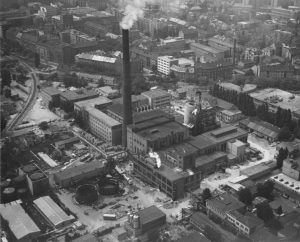SUMMARY
The paper focuses on the construction of railways in Bratislava (before 1918 Pressburg, Pozsony, Prešporok), which was a factor determining the concentration of industrial areas along the railway line, especially on the periphery, but also near railway stations situated on the edge of the current central part of the city. It also analyzes the issue of railways in the city – initially helpful, but gradually hindering its further development.
The idea of connecting Bratislava with Vienna arose in the first half of the 19th century. However, the connection of Bratislava to the steam railway at the border with Austria was unrealistic at that time. Although horse railways were considered archaic in Europe at the time, it was decided such a railway would be built in Bratislava to help with development of the trade in the region. The routing of the railway track and locations of stations were based on several basic tasks – transporting soldiers, horses, commodities and the civilian population. The railway was to connect the city center and the river bank with the port and the industrial district in Mlynské Nivy, with the prospective industrial periphery and towards the wine-growing towns of Rača, Svätý Jur, Pezinok and Modra, through Trnava to Sereď.
The original plan was to connect the Danube port in Bratislava with the port in Sereď. In Bratislava, the railway had a departure station at the inn U zeleného stromu (now the Carlton Hotel) and another station near Trnavské mýto (Bratislava – Blumental station) at the intersection of Krížna and Legionárska streets, from where it continued along Račianska street out of the town. The station, from which the first horse railway train set off in 1840, was designed by the builder Ignác Feigler. The whole railway to Sereď was in full operation since 1846.
At the same time, the idea to build steam traction from Austria persisted. It was successfully completed in 1848, when the first steam train arrived in Bratislava (Pressburg) at the station in Šancová Street. The horse railway was converted to steam in 1873. In this period, factories began to be established near the Bratislava-Blumental station – the Stein brewery and the Ludwig’s mill. The historical cattle market was located at Trnavské mýto too. Therefore, the construction of a modern slaughterhouse was planned in that location, but its premises were completed much later – in 1925 (by the Pittel and Brauswetter company) in Miletičova street. Since the 1870s, also the oldest industrial district in Mlynské Nivy has developed, although at the time, it was not considered the most suitable area for the construction of industrial enterprises. Nevertheless, the largest factories in the city were gradually built there – the Kablo factory, or the Apollo mineral oil refinery.
The station in Šancová Street, where trains from Vienna initially came, could not be connected to the line to Nové Zámky and Pest. Therefore, the construction of the main station began nearby, but the terrain was difficult and it was in a bend. This location of the station was criticized and before long, architects dealing with the regulatory issue came up with the idea of moving the main railway station to the east. Antal Palóczi, the author of regulatory plan (1917), also supported the idea and suggested that the station be relocated. An interesting aspect of his plan was also the construction of an industrial water canal leading from the Danube port to the northeast, where it was to be connected to the Váh river. However, this daring vision, as well as the relocation of the station, were not implemented.
Architects Alois Balán and Jiří Grossmann worked on the design of the station, as well as the design of the area in front of the station, in the interwar period. Despite the fact that the Directorate of Railways was working on the conditions for the reconstruction of the existing station and the railway issue was the main topic of the regulatory competition in 1929, these proposals were not put into practice. Respectively, in the 1930s, there was an initiative to modernize the main station, but this renovation took place later – during World War II – based on the projects of architect Anton Parkman. However, the architecture has been only formally commented on, as it was mainly a question of removing historical elements from the facades of the station building. Plans for the reconstruction of the station and the station area from the 1960s by Ján Baránek and Vojtech Fifík were also not implemented. The same happened at the end of 1980s, when the competition was held again, and the authors of the winning proposal were Karol Hoffmann, Gabriel Koczkáš and Alfréd Rajnica and in 2001, when the competition concerning the reconstruction of the area in front of the station was won by the architecture studio BKPŠ. Eventually, temporary extension of the station building was built in 1990.
The construction of railway stations and the construction of railway lines are processes that accompany the urbanization of cities, and they have occurred in Bratislava since the middle of the 19th century. The railway line, bringing with it the construction of factories, was an important element not only for transport flows of commodities, but also as an urban formation factor. After 1900, the railway, as one of the main attributes of modernization, gradually became a barrier to the development of other types of transport and the construction of new residential structures. It became evident, repeatedly, that the city would develop mainly to the northeast. The presence of railways initially helped this development – it combined the interest of the predominant cargo transport with passenger transport. Later, these two types of transport separated, while passenger rail transport, unlike cargo, was still tolerated in the city. Town planning concepts, which addressed the relocation of the main station and the displacement of railway lines from the city, were only partially realized. They were never implemented as a comprehensive task.


